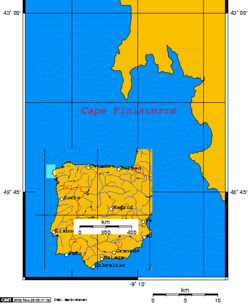Cape Finisterre facts for kids
Quick facts for kids Cape Finisterre |
|
|---|---|

Finisterre on the Atlantic coast of Galicia
|
|
 |
|
| Location | Galicia, |
| Coordinates | 42°52′57″N 9°16′20″W / 42.88250°N 9.27222°W |
| Offshore water bodies | Atlantic Ocean |
| Geology | Cape |
Cape Finisterre (also known as Cabo Fisterra in Galician and Cabo Finisterre in Spanish) is a rocky piece of land sticking out into the sea. You can find it on the west coast of Galicia, Spain.
Long ago, during Roman times, people thought this cape was the very end of the known world! Its name, Finisterre, comes from the Latin words finis terrae, which means "end of the earth."
Even though it's famous for being the "end of the earth," it's not actually the westernmost point of Europe. Cabo da Roca in Portugal is a bit further west. Even in Spain, Cabo Touriñán is slightly more to the west.
The mountain on Cape Finisterre is called Monte Facho. Its highest point is 238 meters (about 780 feet) above the sea. A tall lighthouse stands proudly at the top of Monte Facho. The small town of Fisterra is also very close by.
Long ago, an ancient Celtic tribe called the Artabri lived in this area.
Contents
What is Cape Finisterre Like?
Cape Finisterre has several beautiful beaches. Some of these include O Rostro, Arnela, Mar de Fora, Langosteira, Riveira, and Corbeiro. Many of these beaches are surrounded by tall, steep cliffs. These cliffs drop down to what people in the Middle Ages called the Mare Tenebrosum, or "dark sea." This was their name for the Atlantic Ocean.
There are also some special rocks in this area. Old legends are connected to them. Some are called the "holy stones" or the "stained wine stones." There's even a "stone chair" and a place said to be the tomb of an old Celtic goddess named Orcabella.
Pilgrimage to the End of the World
Cape Finisterre is a very important place for many pilgrims. These are people who travel on a special journey called the Way of St. James. This famous pilgrimage leads to the shrine of Saint James the Great in the Cathedral of Santiago de Compostela. Cape Finisterre is about 90 kilometers (50 miles) from Santiago de Compostela.
No one is completely sure when the pilgrimage to Finisterre first started. However, many believe it began even before Christianity. It might have been linked to the cape being seen as the "edge of the world." It was also a place where people could watch the very last sunset of the day. This tradition continued through the Middle Ages. During that time, special "hospitals" were built to help pilgrims traveling from Santiago de Compostela to Finisterre.
Some pilgrims even walk further to Muxía, which is about a day's walk away.
Ancient Beliefs and History
This area has many old sacred places from before Christianity. These spots are linked to different myths and stories. For example, there was once an "Altar Soli" on Cape Finisterre. Here, the Celts would worship the sun and perform special rituals.
Ancient Greek and Roman historians called the people living near Cape Finisterre the "Nerios." The Nerios were a Celtic group. They used Monte Facho for their offerings and ceremonies to honor the sun. Today, archaeologists are still studying Monte Facho. They have found signs that people lived there around 1000 BCE. There's even an old Roman Road leading to the top of Monte Facho. You can also see the remains of ancient buildings on the mountain.
A person named San Guillerme, also known as St. William of Penacorada, once lived in a house on Monte Facho. Near his house is a stone now called "St William's Stone" (Pedra de San Guillerme).
Battles and Shipwrecks at Sea
Cape Finisterre has a long and interesting history with the sea. Long ago, the Phoenicians sailed from this cape. They traveled to trade with people in Bronze Age Britain.
Because it's a well-known landmark for ships sailing between northern Europe and the Mediterranean, many naval battles have happened near the Cape. Two famous battles include the First Battle of Cape Finisterre in 1747 and the Battle of Cape Finisterre in 1805. These battles were part of bigger wars, like the War of the Austrian Succession and the Napoleonic Wars. In both battles, the British Royal Navy fought against the French Navy. They were always trying to control the seas during the 1700s.
The coast around Cape Finisterre is known as the Costa da Morte, which means "Death Coast." This is because many ships have been wrecked or sunk here. One sad event was the sinking of the British ship HMS Captain in 1870. Nearly 500 lives were lost in that disaster.
The sea area around Finisterre was once used in the UK Shipping Forecast. This forecast gives important weather information to ships. In 2002, the name was changed to FitzRoy. This was to honor the founder of the Met Office, a weather service. It also helped avoid confusion with smaller sea areas that had the same name in French and Spanish forecasts.
More recently, in the 2010s and 2020s, the waters near Cape Finisterre have seen several orca attacks on sailboats.
Gallery
-
Camino de Santiago, Fisterra
See also
 In Spanish: Cabo Finisterre para niños
In Spanish: Cabo Finisterre para niños
- Way of the Lighthouses




